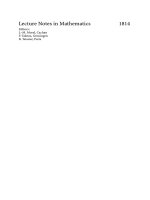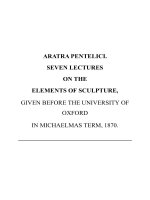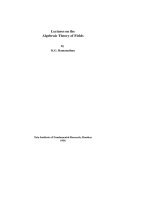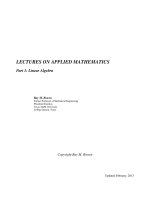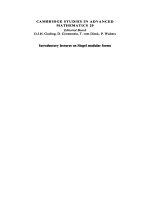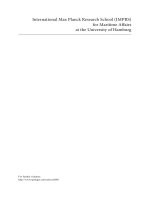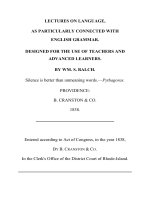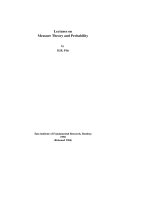(Universitext) juha heinonen (auth ) lectures on analysis on metric spaces springer verlag new york (2001)
Bạn đang xem bản rút gọn của tài liệu. Xem và tải ngay bản đầy đủ của tài liệu tại đây (6.12 MB, 148 trang )
Universitext
Editorial Board
(North America):
S. Axler
F.W. Gehring
K.A. Ribet
Springer Science+Business Media, LLC
U niversitext
Editors (North America): S. Axler, F.W. Gehring, and K.A. Ribet
AksoylKhamsi: Nonstandard Methods in Fixed Point Theory
Andersson: Topics in Complex Analysis
Aupetit: A Primer on Spectral Theory
BachmanINariciIBeckenstein: Fourier and Wavelet Analysis
BalakrishnanlRanganathan: A Textbook ofGraph Theory
Balser: Fonnal Power Series and Linear Systems ofMeromorphic Ordinary
Differential Equations
Bapat: Linear Algebra and Linear Models (2nd ed.)
Berberian: Fundamentals ofReal Analysis
BoossIBleecker: Topology and Analysis
Borkar: Probability Theory: An Advanced Course
BiittcherlSilbermann: Introduction to Large Truncated Toeplitz Matrices
CarlesonlGamelin: Complex Dynamics
Cecil: Lie Sphere Geometry: With Applications to Submanifolds
Chae: Lebesgue Integration (2nd ed.)
Charlap: Bieberbach Groups and Flat Manifolds
Chern: Complex Manifolds Without Potential Theory
Cohn: A Classical Invitation to Algebraic Numbers and Class Fields
Curtis: Abstract Linear Algebra
Curtis: Matrix Groups
DiBenedetto: Degenerate Parabolic Equations
Dimca: Singularities and Topology ofHypersurfaces
Edwards: A Formal Background to Mathematics I alb
Edwards: A Formal Background to Mathematics II alb
Foulds: Graph Theory Applications
Friedman: Algebraic Surfaces and Holomorphic Vector Bundles
Fuhrmann: A Polynomial Approach to Linear Algebra
Gardiner: A First Course in Group Theory
GardingITambour: Algebra for Computer Science
Goldblatt: Orthogonality and Spacetime Geometry
GustafsonlRao: Numerical Range: The Field ofValues ofLinear Operators
and Matrices
Hahn: Quadratic Algebras, Clifford Algebras, and Arithmetic Witt Groups
Heinonen: Lectures on Analysis on Metric Spaces
Holmgren: A First Course in Discrete Dynamical Systems
Howe!fan: Non-Abelian Harmonic Analysis: Applications ofSL(2, R)
Howes: Modem Analysis and Topology
Hsieh/Sibuya: Basic Theory ofOrdinary Differential Equations
HumiIMiller: Second Course in Ordinary Differential Equations
HurwitzlKritikos: Lectures on Number Theory
Jennings: Modem Geometry with Applications
JonesIMorrisIPearson: Abstract Algebra and Famous Impossibilities
KannanIKrueger: Advanced Analysis
KeIlylMatthews: The Non-Euclidean Hyperbolic Plane
Kostrikin: Introduction to Algebra
LueckingIRubel: Complex Analysis: A Functional Analysis Approach
MacLaneIMoerdijk: Sheaves in Geometry and Logic
Marcus: Number Fields
(continued after index)
Juha Heinonen
Lectures on
Analysis on
Metric Spaces
i Springer
Juha Heinonen F.W. Gehring
Mathematics Department Mathematics Department
East HaU East Hali
University of Michigan University of Michigan
Ann Arbor, MI 48109-1109 Ann Arbor, MI 48109-1109
USA USA
Editorial Board
(North America):
S. Axler
Mathematics Department
San Francisco State University
San Francisco, CA 94132
USA
K.A. Ribet
Mathematics Department
University of California at Berkeley
Berkeley, CA 94720-3840
USA
Mathematics Subject Classification (2000): 28Axx, 43A85, 46Exx
Library of Congress Cataloging-in-Publication Data
Heinonen, Juha.
Lectures on analysis on metric spaces / Juha Heinonen.
p. cm - (Universitext)
Inc1udes bibliographical references and index.
ISBN 978-1-4612-6525-2 ISBN 978-1-4613-0131-8 (eBook)
DOI 10.1007/978-1-4613-0131-8
1. Metric spaces. 2. Mathematical analysis. 1. Title. II. Series.
QA611.28.H44 2001
514'.32--dc21 00-056266
Printed on acid-free paper.
© 2001 Springer Science+Business Media New York
Originally published by Springer-Verlag New York, Inc in 2001
Softcover reprint of the hardcover lst edition 2001
All rights reserved. This work may not be translated or copied in whole or in part without
the written permission ofthe publisher (Springer Science+Business Media, LLC), except
for brief excerpts in connection with reviews or scholarly analysis. Use in connection
with any form ofinformation storage and retrieval, electronic adaptation, computer
software, or by similar or dissimilar methodology now known or hereafter developed is
forbidden.The use of general descriptive narnes, trade names, trademarks, etc., in this
publication, even if the former are not especially identified, is not to be taken as a sign
that such names, as understood by the Trade Marks and Merchandise Marks Act, may
accordingly be used freely by anyone.
Production managed by Michael Koy; manufacturing supervised by Jerome Basma.
Typeset by TechBooks, Fairfax, VA.
987654 32 1
ISBN 978-1-4612-6525-2
To my teacher Professor Olli Martio
Preface
Analysis in spaces with no a priori smooth structure has progressed to include con-
cepts from first-order calculus. In particular, there have been important advances
in understanding the infinitesimal versus global behavior of Lipschitz functions
and quasiconformal mappings in rather general settings; abstract Sobolev space
theories have been instrumental in this development. The purpose of this book is
to communicate some of the recent work in the area while preparing the reader to
study more substantial related articles.
The book is a written version of lectures from a graduate course I taught at
the University of Michigan in Fall 1996. I have added remarks and references to
works that have appeared thereafter. The material can roughly be divided into three
different types: classical, standard but sometimes with a new twist, and recent. For
instance, the treatment of covering theorems and their applications is classical,
with little novelty in the presentation. On the other hand, the ensuing discussion
on Sobolev spaces is more modern, emphasizing principles that are valid in larger
contexts. Finally, most ofthe material on quasisymmetric maps is relatively recent
and appears for the first time in book format; one can even find a few previously
unpublished results. The bibliography is extensive but by no means exhaustive.
The reader is assumed to be familiar with basic analysis such as Lebesgue's
theory of integration and the elementary Banach space theory. Some knowledge
of complex analysis is helpful but not necessary in the chapters that deal with
quasisymmetric maps. Occasionally, some elementary facts from other fields are
quoted, mostly in examples and remarks.
The students in the course, many colleagues, and friends made a number of
useful suggestions on the earlier versions of the manuscript and found many errors.
I thank them all. Special thanks go to four people: Bruce Hanson carefully read
viii Preface
the entire manuscript and detected more errors than anyone else; years later, use of
Kari Hag's handwritten class notes preserved the spirit of the class; Fred Gehring
insisted that I prepare these notes for publication; and Jeremy Tyson provided
crucial help in preparing the final version of the text. Finally, I am grateful for
having an inspiring audience for my lectures at Michigan.
Juha Heinonen
Ann Arbor, Michigan
July 1999
Contents
Preface vii
1. Covering Theorems . 1
2. Maximal Functions . 10
3. Sobolev Spaces . .. 14
4. Poincare Inequality . 27
5. Sobolev Spaces on Metric Spaces 34
6. Lipschitz Functions . . . . . . . . 43
7. Modulus of a Curve Family, Capacity, and
Upper Gradients 49
8. Loewner Spaces . 59
9. Loewner Spaces and Poincare Inequalities 68
10. Quasisymmetric Maps: Basic Theory I 78
11. Quasisymmetric Maps: Basic Theory II 88
12. Quasisymmetric Embeddings of Metric Spaces
in Euclidean Space . . . . . . . . 98
13. Existence of Doubling Measures 103
x Contents
14. Doubling Measures and Quasisymmetric Maps . . . . 109
IS. Conformal Gauges . . . . . . . . . . . . . . . . . . . . 119
References 127
Index 137
1
Covering Theorems
All covering theorems are based on the same idea: from an arbitrary cover of a
set in a metric space, one tries to select a subcover that is, in a certain sense, as
disjointed as possible. In order to have such a result, one needs to assume that the
covering sets are somehow nice, usually balls. In applications, the metric space
normally comes with a measure /-L, so that if F = {B} is a covering of a set A by
balls, then always
/-L(A)::: L/-L(B)
F
(with proper interpretation of the sum if the collection F is not countable). What
we often would like to have, for instance, is an inequality in the other direction,
/-L(A) 2: C L /-L(B),
F'
for some subcollection F' c F that still covers A and for some positive constant C
that is independent of A and the covering F. There are many versions of this theme.
In the following, we describe three covering theorems, which we call the basic
covering theorem, the Vitali covering theorem, and the Besicovitch-Federer cov-
ering theorem. (The terms may not be standard.) Each of these three theorems has
a slightly different purpose, as well as different domains of validity, and I have
chosen them as representatives of the many existing covering theorems. We will
not strive for the greatest generality here.
1.1 Convention. Let X be a metric space. When we speak of a ball B in X, it is
understood that it comes with a fixed center and radius, although these in general
J. Heinonen, Lectures on Analysis on Metric Spaces
© Springer Science+Business Media New York 2001
2 Lectures on Analysis on Metric Spaces
are not uniquely determined by B as a set. Thus, B = B(x, r}, and we write
AB = B(x, Ar} for A> O. In this chapter, unless otherwise stated, a ball B can be
either open or closed, with the understanding that AB is of the same type.
We will use the Polish distance notation
Ix - yl
in every metric space, unless there is a specific need to do otherwise.
A family of sets is called disjointed if no two sets from the family meet.
Theorem 1.2 (basic covering theorem). Every family F of balls ofuniformly
bounded diameter in a metric space X contains a disjointed subfamily g such
that
U Be USB.
BeF Beg
In fact, every ball B from F meets a ballfrom g with radius at least halfthat ofB.
For the proof, recall the following version of Zorn's lemma: If every chain in a
nonempty partially ordered set has an upper bound, then the partially ordered set
has a maximal element.
PROOF. Let Q denote the partially ordered (by inclusion) set consisting of all dis-
jointed subfamilies w of F with the following property: If a ball B from F meets
some ball from w, then it meets one whose radius is at least half the radius of B.
Then, if CeQ is a chain, it is easy to see that
Wo=Uc w
belongs to Q, so there is a maximal element g in Q. By construction, g is disjointed.
(Note that Q is nonempty because the one ball family w = {B} is in Q whenever
B E F has radius close to the supremal one.)
If there is a ball B in F that does not meet any ball from g, then pick a ball Bo
from F such that the radius of Bo is larger than half of the radius of any other ball
that does not meet the balls from g. Then, if a ball B from F meets a ball from the
collection g' = g U {Bo}, by construction it meets one whose radius is at least half
that of B, showing that g' belongs to Q. But this contradicts the maximality of g.
Thus, every ball B = B(x, r} from F meets a ball B' = B(x', r'} from g so that
r ::: 2r', and the triangle inequality shows that B e SB'. The theorem follows. 0
Remark 1.3. (a) In Theorem 1.2, g is not asserted to be countable, although in
applications it often will be.
(b) The proof of Theorem 1.2 in [47, 2.8] applies to more general coverings than
those by balls.
1. Covering Theorems 3
(c) Zorn's lemma is equivalent to the axiom of choice; see, for example, [91,
Chapter 1]. A constructive proof for Theorem 1.2 is possible with mild additional
assumptions on X. For instance, in [134,2.1] one finds a simple geometric argument
in the event that the closed balls in X are compact. The idea is that one begins to
select a disjointed collection by always picking out nearly the largest ball possible.
In this setting, 9 will also be countable.
(d) Simple examples show that the assumption "of uniformly bounded diameter"
in Theorem 1.2 is necessary.
1.4 Convention. A measure in this book means a nonnegative countably sub-
additive set function defined on all subsets of a metric space. All measures are
furthermore assumed to be Borel regular, which means that open sets are measur-
able and every set is contained in a Borel set with the same measure. If f is an
extended real-valued function on a metric measure space (X, JL), we keep using
the notation
lfdJL
even if the measurability of f is not clear; the meticulous reader should interpret
this as an upper integral of f [47,2.4.2].
A measure JL in a metric space is called doubling if balls have finite and positive
measure and there is a constant C(JL) ::: 1 such that
(1.5)
for all balls B. We also call a metric measure space (X, JL) doubling if JL is a
doubling measure. Note that condition (1.5) implies
for all A ::: 1. We adopt the convention that C(JL) always denotes a constant that
depends only on the constant in the doubling condition (1.5) but may not be the
same at each occurrence. In general, we denote by C a positive constant whose
dependence on some data is clear from the context.
Under rather general circumstances, Borel regular measures have two useful
properties, which are often called inner regularity and outer regularity. More
precisely, if JL is a Borel regular measure, then for each Borel set A of finite
measure JL(A) is the supremum of the numbers JL(C), where C runs through all
closed subsets of A; moreover, if the metric balls have finite measure, and A is a
Borel set, then JL(A) is the infimum of the numbers JL(U), where U runs through
all open supersets of A. See [47, 2.2.2].
Theorem 1.6 (Vitali covering theorem). Let A be a subset in a doubling metric
measure space (X, JL). and let F be a collection of closed balls centered at A
such that
inf{r > 0: B(a, r) E F} = 0 (1.7)
4 Lectures on Analysis on Metric Spaces
for each a E A. Then. there is a countable disjointed subfamily g of F such
that the balls in g cover JL almost all of A. namely
PROOF. Assume first that A is bounded. Next, we may assume that the balls in F
have uniformly bounded radii; in particular, by the basic covering theorem, we find
a disjointed subcollection g of F such that A is contained in UgSB. Moreover,
the union Ug B is contained in some fixed ball, and hence, because JL is doubling,
the collection g = (BI , B2, ...J is necessarily countable. We find, by using the
doubling property of JL, that
i~1 i~1
which implies that
as N -+- 00. Therefore, it suffices to show that
A\QBi C ildSBi'
To this end, take a E A \ Uf::1 Bi. Because the balls in F are closed, we can find
a small ball B(a, r) E F that does not meet any of the balls Bi for i ~ N. On
the other hand, by the basic covering theorem, the family g can be chosen so that
B(a, r) meets some ball Bj from g with radius at least rj2. Thus, j > Nand
B(a, r) C SBj, as required.
We leave it to the reader to treat the case where A is unbounded. This completes
the proof. 0
Classically, the main application of the Vitali covering theorem is the following
differentiation theorem of Lebesgue.
Theorem 1.8 (Lebesgue's ditTerentiation theorem). If f is a nonnegative.
locally integrable function on a doubling metric measure space (X, JL). then
lim i f dJL = f(x) (1.9)
r--+O JB(x.r)
for almost every x E X.
1. Covering Theorems 5
In Eq. (1.9), and throughout the book, we use the notation
f IE = 1 f dJL = _1_ f dJLJE (1.10)
JL(E)
for the mean value of f in E. A function is said to be locally integrable if every
point has a neighborhood where the function is integrable. Similarly, we have
locally p-integrable functions, and the notation Lfoc' Lfoc(JL), Lfoc(X), . .. is used.
PROOF. If E denotes the set of points in X where Eq. (1.9) does not hold, cover
E by closed balls with centers at E and radii so small that f is integrable in each
ball; by the Vitali covering theorem, there is a countable union of balls of this kind
containing almost every point of E. Thus, it suffices to show that E has measure
zero in a fixed ball B where f is integrable.
To this end, we first claim that if t > 0 and if
lim inf 1 f dJL ::: t (1.11)
r~O JB(x.r)
for each x in a subset A of B, then
i f dJL ::: tJL(A).
To prove this claim, fix E > 0 and choose an open superset U of A such that
JL(U) ::: JL(A) + E (see 1.4). Then, each point in A has arbitrarily small closed ball
neighborhoods contained in U where the mean value of f is less than t + E. The
Vitali covering theorem implies that we can pick a countable disjointed collection
of such balls covering almost all of A, from which
and Eq. (1.11) follows upon letting E --+ O. A similar argument shows that if t > 0
and if
for all x E A C B, then lim sup 1 f dJL ::: t
r~O JB(x.r) (1.12)
i f dJL ::: t JL(A).
It follows, in particular, that
lim sup 1 f dJL < 00
r~O JB(x.r)
6 Lectures on Analysis on Metric Spaces
for almost every x E B. On the other hand, if As" is the set of points x in B for
which
liminf 1 f dt-t ~ s < t ~ lim sup 1 f dt-t,
,-+0 JB(x,,) ,-+0 JB(x,,)
then t-t(As ,,) = 0, for Eqs. (1.11) and (1.12) together imply
tt-t(As,,) ~ i", f dt-t ~ st-t(As,,).
Thus, the limit on the left in Eq. (1.9) exists and is finite almost everywhere in B.
Denote this limit by g(x) whenever it exists. It remains to show that g(x) = f(x)
almost everywhere in B.
Fix both a set FeB and E > 0; for each integer n, denote
An = {x E F: (I +Et ~ g(x) < (I + Et+1}.
Then, by Eq. (1.12),
{ g dt-t = L ( g dt-t ~ L(l + E)n+1 t-t(An)
JF nJAn n
and similarly, by Eq. (1.11),
{gdt-t =L ( gdt-t ~ L(l+E)nt-t(An)
JF n JAn n
By letting E ---* 0, we infer that
and hence that g = f almost everywhere in B. The theorem follows. D
Remark 1.13. The preceding proof of Lebesgue's differentiation theorem does
not need the underlying space to be doubling; it is enough that balls in X have
finite mass and that the Vitali covering theorem holds. Also note that for the Vitali
covering theorem the hypothesis that (X, t-t) be doubling is unnecessarily strong.
Thus, let us call a metric measure space (X, t-t) a Vitali space if balls in X have
finite measure and if for every set A in X and for every family :F of closed balls
in X satisfying Eq. (1.7) the conclusion of Theorem 1.6 holds. Then, Lebesgue's
differentiation theorem (Theorem 1.8) holds in each Vitali space in the sense
1. Covering Theorems 7
that Eq. 0.9) holds 11 almost everywhere for each nonnegative locally integrable
function f on a Vitali space (X, 11).
If 11 is any Radon measureI in lR", then (lR", 11) is a Vitali space; in partic-
ular, Lebesgue's differentiation theorem holds in lR" whenever f is a locally
Il-integrable function and 11 is a Radon measure. (See [134, Theorem 2.8, p.
34].) For a more general statement, see Example 1.15 (f).
In the basic covering theorem, one would often like to have controlled overlap
for the balls 5 B with B E 9. In general, this is impossible. An easy example to this
effect is a space consisting of a union of infinitely many line segments of radius 1
emanating from a point in Euclidean space equipped with its internal (path) metric.
The problem with this space is that it has too many directions lying too far apart at
the common point. Next, we borrow a condition from [47, 2.8.14] on a set A eX,
which guarantees a controlled overlap.
A set A in a metric space X is said to be directionally (E, M) limited iffor each
a E A there are at most M distinct points bl , ... ,bp in B(a, E) n A such that for
i #- j and x E X
la - x I + Ix - bi! = la - bi! and la - bj I = la - x I
imply
1
Ix - bjl ::: 41a - bjl.
Here, the ball B(a, E) is assumed to be open.
Theorem 1.14 (Besicovitch-Federer covering theorem). If A is a direction-
ally (E, M) limited subset of X and ifF is a family of closed balls centered at
A with radii bounded by E > 0, then there are 2M + 1 disjointed subfamilies
91, ... , 92M+I ofF such that
2M+I
Ac U U B.
;=1 BEf;;
Note that E > 0 plays no role in the conclusion; it represents the scale where
events are allowed to take place, and it could be large.
For a proof of Theorem 1.14, see [47, 2.8.14]. Because of its rather limited
domain of validity, Theorem 1.14 will not be used in this book.
Example 1.15. (a) In a finite-dimensional normed space X, every set is direction-
ally (E, M) limited for all E > 0 and for some M depending only on the dimension
of the space. To see this, we may assume that A = X and that a = O. Take two
I A Radon measure is a Borel regular measure that gives a finite mass to each compact set.
8 Lectures on Analysis on Metric Spaces
distinct points bi and bj with Ibi 1:::: Ib j I, and write
Then, suppose
But because there are only a finite number (depending on the dimension) of points
on the unit sphere in a normed space that lie distance ~ apart,2 we have a bound
for the number of points b) , ... , bp.
(b) An infinite orthonormal set {e), e2, ... } in a Hilbert space is not directionally
(E", M) limited if E" > 1.
(c) Any compact subset A of a Riemannian manifold is directionally (E", M)
limited for some E" = €(A) > 0 and M = M(n), where n is the dimension of
the manifold. This is proved by using the compactness of A and the fact that for
each a E A and for each a> 0 the exponential map is (1 + a)-bi-Lipschitz in a
sufficiently small neighborhood of the origin in the tangent space at a. See [47,
2.8.9].
(d) In contrast to (c), Chi [33] has proved that if a simply connected nonpositively
curved Riemannian manifold covering a compact manifold satisfies a Besicovitch':'"
Federer type covering theorem, then the manifold is isometric to ]Rn.
(e) The Heisenberg group equipped with its Carnot metric (see Section 9.25)
does not satisfy the Besicovitch-Federer covering theorem as it is presented in
Theorem 1.16 for X = ]Rn. See [111, 1.4].
(t) If X is a separable metric space that is a countable union of directionally
limited subsets, then (X, /L) is a Vitali space as defined in Remark 1.13 whenever
/L is a (Borel) measure such that /L(B) < 00 for all balls B in X. See [47, 2.8.18].
To finish the chapter, let us record the following version of the classical Besi-
covitch covering theorem.
Theorem 1.16. Let A be a bounded set in a metric space X and:F be a collection
ofballs centered at A. Then, there is a subcollection g c :F such that
AC UB
Beg
and that
2Every n-dimensional Banach space is homeomorphic to IRn by an Jii-bi-Lipschitz linear map by
a theorem of John; see [140. p. 10].
1. Covering Theorems 9
is a disjointed family ofballs. Moreover, if X carries a doubling measure, then
9 is countable, and if X = ]Rn, then one can choose 9 such that
L XB(X) ::: C(n) < 00
BEy
for some dimensional constant C(n), where XE denotes the characteristic func-
tion ofa set E.
The first assertion is merely a special case of the basic covering theorem (Theo-
rem 1.2), and if X carries a doubling measure, it is clear that 9 has to be countable.
For a simple proof of the last assertion, see, for example, [134, 2.7] or [136, 1.2.1].
Of course, the last assertion also follows from Theorem 1.14.
1.17 Notes to Chapter 1. The material here is classical and can be found in
many textbooks. In particular, [47,2.8] contains a comprehensive study ofcovering
theorems. See also [45] and [134]. Historically, covering theorems were developed
in connection with the differentiation theory of real functions, which is one of the
triumphs of Lebesgue's theory; see [22] and [91].
2
Maximal Functions
Throughout this chapter, (X, JL) is a doubling metric measure space.
Maximal functions are important everywhere in geometric analysis, and they
will playa major role in this book. For a locally integrable real-valued function f
in X, define
M(f)(x) = sup 1 If IdJL, (2.1)
r>O JB(X,r)
where, we recall, the barred integral sign denotes the mean value. A comparable
function results if the supremum is taken over all balls containing x rather than
those centered at x.
Recall from Chapter 1 that Lebesgue's differentiation theorem holds in the
present setting: if f is locally integrable, then
lim 1 If IdJL = If(x)1
r-->O JB(X,r)
for almost every x E X. Thus, the maximal function M(f) is always at least as
large as If I (in the almost everywhere sense), and the important maximal function
theorem of Hardy and Littlewood asserts that M(f) is not much larger when
measured as an LP function for p > 1; in the case p = 1, the situation is different,
as explained in Remark 2.5 (a).
Theorem 2.2 (maximal function theorem). The maximalfunction maps L 1(JL)
to weak - L 1(JL) and LP(JL) to LP(JL)for p > 1 in the following precise sense:
J. Heinonen, Lectures on Analysis on Metric Spaces
© Springer Science+Business Media New York 2001
2. Maximal Functions 11
for all t > 0, we have
Cil 1L({M(f) > t}) ::: -t x IfI dlL (2.3)
and
Ix IM(f)iPdlL ::: Cp Ix Ifl P dlL (2.4)
whenever f belongs to L I (IL) in inequality (2.3) or to LP(IL) for p > 1 in
inequality (2.4). The constants C I and Cp depend only on p and on the doubling
constant of IL·
PROOF. The proof of inequality (2.3) is a simple application of the basic covering
theorem. In that theorem, however, one requires that the balls in the covering
have uniformly bounded diameter. Therefore, we must consider restricted maximal
functions MR(f), for 0 < R < 00, which are defined as in Eq. (2.1) but the
supremum is now taken only over the radii 0 < r < R. The estimates proved in the
following will be independent of R, and inequalities (2.3) and (2.4) follow by letting
R --+ 00. With this understood, we proceed with the notation MR(f) = M(f).
For each x in the set {M(f) > t}, we can pick a ball B(x, r) such that
( IfI dlL > tlL(B(x, r»,
iB(X,r)
and extracting from this collection of balls a countable subcollection 9 as in the
basic covering theorem (Theorem 1.16), we see that
IL({M(f) > t}) ::: L 1L(5B) ::: C L IL(B)
9 9
::: £ L 11/1 dlL ::: C 11/1 dlL,
t9 B t X
as desired. Note that both the doubling property of IL and the disjointedness of the
family 9 were used in the argument.
To prove inequality (2.4), we divide a given LP(IL) function f into a good part
and a bad part,
f = f . X{f5.l/2} + I . X{f>1/2} =: g + b,
with t > 0 fixed, where X* denotes the characteristic function. Then,
M(f) ::: M(g) + M(b)::: tl2 + M(b),
which implies that
{M(f) > t} c {M(b) > t 12}.
Using this observation, the weak estimate (2.3), and writing the formula for the

